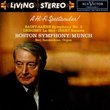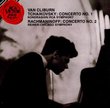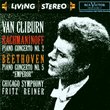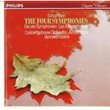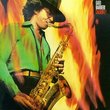| All Artists: Cortot-Thibaud-Casals Trio Title: Great Recordings of the Century: Beethoven "Archduke" Piano Trio and Schubert Piano Trio in B flat Members Wishing: 1 Total Copies: 0 Label: EMI Classics Release Date: 9/14/1999 Genre: Classical Styles: Chamber Music, Historical Periods, Classical (c.1770-1830), Modern, 20th, & 21st Century, Symphonies Number of Discs: 1 SwapaCD Credits: 1 UPC: 724356700123 |
Search - Cortot-Thibaud-Casals Trio :: Great Recordings of the Century: Beethoven "Archduke" Piano Trio and Schubert Piano Trio in B flat
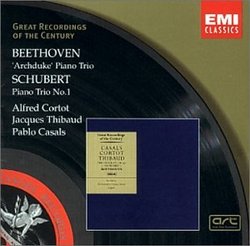 | Cortot-Thibaud-Casals Trio Great Recordings of the Century: Beethoven "Archduke" Piano Trio and Schubert Piano Trio in B flat Genre: Classical
More than 70 years have passed since the Cortot-Thibaud-Casals trio waxed the Schubert B flat and Beethoven Archduke trios. Both recordings were hailed as classics in the early days of electrical recording and have enjoyed... more » |
Larger Image |
CD DetailsSynopsis
Amazon.com essential recording More than 70 years have passed since the Cortot-Thibaud-Casals trio waxed the Schubert B flat and Beethoven Archduke trios. Both recordings were hailed as classics in the early days of electrical recording and have enjoyed numerous incarnations on LP and CD. Even if you already own these performances, you honestly haven't heard them until you experience these new restorations. The effect is not unlike washing your eyeglasses. All the surface snap, crackle, and swish has been tamed, but more room tone emerges along with long-buried, intermingling overtones from all three instruments. There's more tempo fluctuation than modern ears may be accustomed to, along with Thibaud's slippery portamentos. Yet these devices are channeled toward specific expressive ends. Mannered they may seem, but indulgent, never. And listeners used to Cortot's freewheeling approach to solo repertoire will be surprised at how much he behaves himself in a chamber music context. Write, petition, call, beg, cajole, do anything to induce EMI to bring out the remainder of this trio's recorded output in equally amazing transfers. --Jed Distler Similarly Requested CDs
|
CD ReviewsThe greatest of all trios Peter G. Watchorn | Cambridge, MA USA | 09/28/2003 (5 out of 5 stars) "When Alfred Cortot, Jaques Thibaud and Pablo Casals formed their trio in 1905, their intention was simply to make music together as three friends, each with a very busy solo career to maintain. They became, for reasons which the present recordings make very clear, THE trio. It was indeed fortunate that, after twenty years of their performing for one month out of each year together, the Gramophone Company persuaded them to commit a small representative selection of their repertoire to the new medium of "electrical" recording, introduced in 1925. It was this new medium which made the recording of chamber music viable for the first time.The first recording to be made was also the best: the legendary Schubert trio Op. 99. Not only did it have the very real advantage of being recorded in London's Kingsway Hall, but the Cortot-Thibaud-Casals trio over twenty years had obviously made the piece their own. Of all the performances they committed to wax, this was the only one to be recorded without any re-taking. This means that the first "take" of each 4 minute side was the one that was released. This was certainly not true for Beethoven's "Archduke", which required many takes for a number of the sides. Clearly, they found this piece more difficult to penetrate.The characteristics of this trio which made them great - far greater as chamber musicians than, for example, great virtuosi such as Heifetz, Rubinstein and Feuermann (who also recorded as a trio) - were their exemplary sense of give and take, their expressive range and their miraculous rhythmic flexibility. Just listen to Thibaud's marvellous tone in the slow movement of the Schubert - his use of vibrato ranges all the way from none (the very last note!) to continuous expressive vibrato where it's warranted. Casals plays sthe cello in every style possible, from non-vibrato "continuo" style to the expressive manner befitting the soloist. Both string players are not shy of portamenti, so uncommon in our modern clinical age, but to them (and probably to Schubert and Beethoven) an essential expressive device. Cortot is the glue that binds it all together. The wonderful flexibility displayed by each player also underscores another characteristic of this trio - a real sense of the music's structure and design. Clearly, these players knew each part of these trios, and not only their own. Just listen to this particular transfer: the Kingsway Hall (Schubert) sounds marvellous and the tone of Cortot's piano (a beautiful instrument, impeccably tuned, by the way) is pure magic. The ear adjusts quickly to the recorded sounds of 1926 and 1928. There are innumerable features which make this recording great and it's futile to attempt to list them there. Much better to invest in a copy instead. If I were attempting to demonstrate great musicianship to a younger student, in ways that cannot be conveyed in words, I'd simply play them this recording of the Schubert. It speaks for itself and it's no accident that it has never been out of circulation since 1926.The Archduke trio also provides compelling music making, although the sound (not recorded in the Kingsway, unfortunately) is not as good as that of the Schubert of two years before. Actually, for my money, part of the problem is with the work itself - it just doesn't seem to have the same tightness and unity as the Schubert. Cortot is also a little more prone to his famous penchant for hitting wrong notes, but it really doesn't matter: the music's all there. Cortot, Thibaud and Casals also recorded the Mendelssohn d minor trio, the Schumann d minor and the Haydn trio, the "Gypsy " rondo. Also, a set of variations by Beethoven was included in the same sessions as the Schubert. Nothing is more musically rewarding than to listen to the greatest performers of the twentieth century in this repertoire. The world of Cortot, Thibaud and Casals is one which has now vanished-forever. There is simply no longer playing like this to be heard. No chamber music lover can afford to miss these definitive recordings. And, of all the transfers I've heard (over 40 years), beginning with the original HMV 78's, DB 947-50 (Schubert), this is the best. Strongest recommendation." Amusing golden musical treasures! Hiram Gomez Pardo | Valencia, Venezuela | 08/23/2004 (5 out of 5 stars) "No matter if the sound is not the best . You and me know the meaning of these recordings . The pleasure of enjoying such trio with this giant trio Thibaud , Cortot and Casals makes you soon forget the delightful sound of DDD for instance . The Archiduke is plenty of soverignity . However I rather prefer the recording of 1960 with Casals (84) , Vegh and Horszowski . Nevertheless this commented version is much more lyrical than the sixties . Thibaud with his flamboyant and nuance vibrato literally sings all along the work , Casals is the real master and commander in this performing and Cortot knows how enter with his cantabile without forcing or shade the principal voice . The Schubert trio is anthological . To me it was the best recording till that overwhelming version of Stern , Istomin and Rose . You may well consider both of them as one two winners in all the discography . This album is really a treasure file . Casals was the most gifted musician - plenty of commitment and mercurial magnetism - in all the XX century . He was the Midas musician for excellence!" The joy of pure music making! Pupil | Malkuth | 09/29/2003 (5 out of 5 stars) "To me, this is what music making is all about.
The performance of Archduke on this disc is so loyal, so friendly, so charming and so so musical that one feels as though they are sitting down for an intimate exchange with the Old World herself. Enjoy!" |

 Track Listings (8) - Disc #1
Track Listings (8) - Disc #1
